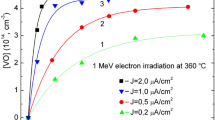Abstract
The present experiments using fast electron and gamma-irradiation are aimed at checking the model of defect formation in oxygen-lean n-Si(FZ) in a quantitative way. Electrical measurements are taken over a wide temperature range of 20 to 300 K. Analysis of equations of charge balance making use of the statistics of charge carriers in non-degenerate semiconductors demonstrates that group-V impurity atoms strongly interact with intrinsic point defects. As a result, the concentration of shallow donor states is markedly decreased. This loss of shallow donors, −δN D , is accompanied with an increase in the concentration of radiation-produced deep acceptors, +δN rad A , being equal in magnitude but opposite in sign. Such behavior correlates quantitatively with the formation model of donor-vacancy pairs put forward earlier by Watkins and Corbett, what has been proved on the basis of electrical data for the first time. The formation kinetics of these complexes is discussed. Defects of interstitial type in irradiated material appear to be electrically neutral in n-Si. However, their production in the course of electron- and gamma-irradiation is believed to be responsible for drastic changes in the mobility of charge carriers at cryogenic temperatures.
Similar content being viewed by others
References
G. D. Watkins, J. W. Corbett, and R. M. Walker, J. Appl. Phys. 30, 1198 (1959).
G. D. Watkins and J. W. Corbett, Phys. Rev. 121, 1001 (1961).
G. D. Watkins and J. W. Corbett, Phys. Rev. 134, A1359 (1964).
E. L. Elkin and G. D. Watkins, Phys. Rev. 174, 881 (1968).
A. Nylandsted Larsen, A. Mesli, K. Bonde Nielsen, H. Kortegaard Nielsen, L. Dobaczewski, J. Abey, R. Jones, D. W. Palmer, P. R. Briddon, and S. Öberg, Phys. Rev. Lett. 97, 106402 (2006).
J. S. Blakemore, Semiconductor Statistics (Pergamon, Oxford, 1962).
A. K. Ramdas and S. Rodriguez, Rep. Prog. Phys. 44, 1297 (1981).
B. Lax, H. J. Zeiger, and R. N. Dexter, Physica 20, 818 (1954).
J. C. Hensel, H. Hasegawa, and M. Nakayama, Phys. Rev. 138, 225 (1965).
G. D. Watkins, in Materials Science and Technology, Ed. by R. W. Chan, P. Haasen, and E. J. Kramer (Wiley-VCH, 2005), Vols. 4–5, ch. 3, pp. 107–138.
N. A. Vitovskii, V. V. Emtsev, T. V. Mashovets, Yu. G. Morozov, Sov. Phys. Semicond. 8, 1489 (1975).
J. W. Corbett, and G. D. Watkins, Phys. Rev. 138, A555 (1965).
F. J. Morin and J. P. Maita, Phys. Rev. 96, 28 (1954).
D. Long and J. Myers, Phys. Rev. 115, 1107 (1959).
F. J. Blatt, Physics of Electronic Conduction in Solids (McGraw-Hill, 1968).
V. V. Emtsev, N. V. Abrosimov, V. V. Kozlovskii, and G. A. Oganesyan, Fiz. Tekh. Poluprovodn. 48(12), 1592 (2014).
C. S. Chen, J. C. Corelli, and G. D. Watkins, Phys. Rev. B 5, 510 (1972).
Author information
Authors and Affiliations
Corresponding author
Additional information
The article is published in the original.
Rights and permissions
About this article
Cite this article
Emtsev, V.V., Abrosimov, N.V., Kozlovskii, V.V. et al. Vacancy-donor pairs and their formation in irradiated n-Si. Semiconductors 48, 1438–1443 (2014). https://doi.org/10.1134/S1063782614110098
Received:
Accepted:
Published:
Issue Date:
DOI: https://doi.org/10.1134/S1063782614110098




